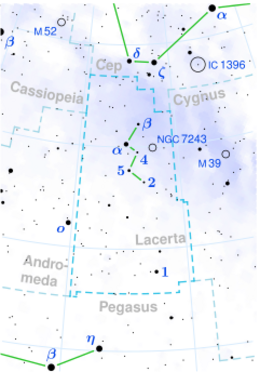Astronomy:10 Lacertae
| Observation data Equinox J2000.0]] (ICRS) | |
|---|---|
| Constellation | Lacerta |
| Right ascension | 22h 39m 15.67864s[1] |
| Declination | +39° 03′ 00.9712″[1] |
| Apparent magnitude (V) | 4.880[2] |
| Characteristics | |
| Spectral type | O9VCite error: Closing </ref> missing for <ref> tag
|
| Astrometry | |
| Radial velocity (Rv) | −10.10[3] km/s |
| Proper motion (μ) | RA: −0.32[1] mas/yr Dec.: −5.46[1] mas/yr |
| Parallax (π) | 1.89 ± 0.22[1] mas |
| Distance | 715[4] pc |
| Absolute magnitude (MV) | −4.40[5] |
| Details[5] | |
| Mass | 26.9 M☉ |
| Radius | 8.27 R☉ |
| Luminosity | 102,000 L☉ |
| Surface gravity (log g) | 4.03 cgs |
| Temperature | 36,000 K |
| Rotational velocity (v sin i) | 35 km/s |
| Other designations | |
| Database references | |
| SIMBAD | data |
10 Lacertae (10 Lac) is a star in the constellation Lacerta. With an apparent magnitude of 4.9, it is located around 700 parsecs (2,300 ly) distant in the small Lacerta OB1 association. It is a hot blue main-sequence star of spectral type O9V, a massive star that is currently fusing its core hydrogen. It is a suspected Beta Cephei variable star.
10 Lacertae was one of the first O-type stars (along with S Monocerotis) to be defined as an anchor point for the MKK spectral classification; since the early twentieth century it has served as such a point. Specifically, the star is representative of O9V stars, meaning relatively cool O-type stars on the main-sequence.[6]
10 Lacertae has an 8th magnitude companion about one arc-minute away.[7]
References
- ↑ 1.0 1.1 1.2 1.3 1.4 van Leeuwen, F. (November 2007). "Validation of the new Hipparcos reduction". Astronomy and Astrophysics 474 (2): 653–664. doi:10.1051/0004-6361:20078357. Bibcode: 2007A&A...474..653V.
- ↑ Oja, T. (September 1993). "UBV photometry of stars whose positions are accurately known. VII". Astronomy and Astrophysics Supplement Series 100 (3): 591–592. ISSN 0365-0138. Bibcode: 1993A&AS..100..591O.
- ↑ Gontcharov, G. A. (2006). "Pulkovo Compilation of Radial Velocities for 35 495 Hipparcos stars in a common system". Astronomy Letters 32 (11): 759–771. doi:10.1134/S1063773706110065. Bibcode: 2006AstL...32..759G.
- ↑ Kaltcheva, N.; Golev, V. (2011). "Improved Distances to Several Galactic OB Associations". Stellar Clusters & Associations: A RIA Workshop on Gaia.: 299–303. Bibcode: 2011sca..conf..299K.
- ↑ 5.0 5.1 Mokiem, M. R.; de Koter, A.; Puls, J.; Herrero, A.; Najarro, F.; Villamariz, M. R. (October 2005). "Spectral analysis of early-type stars using a genetic algorithm based fitting method". Astronomy and Astrophysics 441 (2): 711–733. doi:10.1051/0004-6361:20053522. Bibcode: 2005A&A...441..711M.
- ↑ Garrison, R. F. (1994). "A Hierarchy of Standards for the MK Process". Astronomical Society of the Pacific 60: 3. Bibcode: 1994ASPC...60....3G.
- ↑ Dommanget, J.; Nys, O. (1994). "Catalogue of the Components of Double and Multiple stars (CCDM). First edition.". Communications de l'Observatoire Royal de Belgique 115. Bibcode: 1994CoORB.115.....D.
 |


